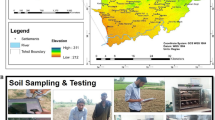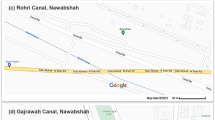Abstract
The present study's goal is to evaluate surface water quality using integrated techniques of remote sensing, geographic information systems (GIS), and the Internet of Things (IoT). The Landsat 9 operational land image (OLI) was downloaded from Earth Explorer on February 5, 2023, and water sampling was conducted along the Vaigai River in Madurai, Tamil Nadu, India, on the same day. To verify the accuracy of the IoT and remote sensing data, 14 samples were taken at random from various locations in Vaigai and studied in a laboratory. At the same areas where samples were taken for in situ analysis, along the Vaigai River, pH and TDS sensors were utilized to measure the values. This study establishes the applicability of Landsat 9 and regression analysis for estimating the water quality parameters such as pH, total dissolved solids (TDS), nitrates (NO3), ammonia (NH3), electrical conductivity (EC), sodium (Na), calcium (Ca), potassium (K), and biochemical oxygen demand (BOD) through the correlation between Landsat 9 bands and in situ measurements. The outcomes of the regression analysis demonstrate a strong correlation between the Landsat 9 OLI band 1 reflectance values and the water quality indices of NO3, NH3, and BOD. TDS and band 3 reflectance levels had a strong correlation. Band 4 reflectance values of Landsat 9 OLI were well associated with the remaining parameters of pH, EC, Na, Ca, and K. The in situ and IoT analysis of sample data best matches the estimated values of water quality parameters based on regression analysis. Therefore, this integrated technique is a powerful platform compared to conventional methods for analysing and processing big data and remotely mapping geographic areas with greater accuracy and speed. This study advises researchers to use the methods of remote sensing, GIS, and IoT to accurately estimate future challenges connected to water quality assessments. Future research will continuously collect more water samples and water quality metrics from inland waters in various situations to increase the generalizability of the models in order to achieve integration.




Similar content being viewed by others
Data Availability
Availability of data and material is not restricted.
References
Batur, E., & Maktav, D. (2019). Assessment of surface water quality by using satellite images fusion based on PCA method in the Lake Gala, Turkey. IEEE Transactions on Geoscience and Remote Sensing, 57(5), 2983. https://doi.org/10.1029/2018RG000598
Carlson E, Ecker MD, Falls C (2002). A statistical examination of water quality in two Iowa Lakes. American Journal of Undergraduate Research, 1(2), 31–45. https://doi.org/10.33697/ajur.2002.015
Carstens, D., & Amer, R. (2019). Spatio-temporal analysis of urban changes and surface water quality. Journal of Hydrology, 569, 720–734. https://doi.org/10.1016/j.jhydrol.2018.12.033
Chowdurya, M. S. U., Emranb, T. B., Ghosha, S., Pathaka, A., Alama, M. M., Absara, N., Anderssonc, K., & Hossaind, M. S. (2019). IoT based real-time river water quality monitoring system. Procedia Computer Science., 155, 161–168. https://doi.org/10.1016/j.procs.2019.08.025
Flores-Anderson, A. I., Griffin, R., Dix, M., Romero-Oliva, C. S., Ochaeta, G., Skinner-Alvarado, J., Moran, M. V. R., Hernandez, B., Cherrington, E., Page, B., & Barreno, F. (2020). Hyperspectral satellite remote sensing of water quality in Lake Atitlán. Guatemala. Front. Environ. Sci., 8, 7. https://doi.org/10.3389/fenvs.2020.00007
Gholizadeh, M. H., Melesse, A. M., & Reddi, L. (2016). A comprehensive review on water quality parameters estimation using remote sensing techniques. Sensors, 16(8), 1298. https://doi.org/10.3390/s16081298
Hedger, R. D., Atkinson, P. M., & Malthus, T. (2001). Optimizing sampling strategies for estimating mean water quality in lakes using geostatistical techniques with remote sensing. Lakes & Reservoirs: Research & Management, 6(4), 279–288. https://doi.org/10.1046/j.1440-1770.2001.00159.x
Huang, C., Chen, Y., Zhang, S., & Wu, J. (2018). Detecting, extracting, and monitoring surface water from space using optical sensors: A review. Reviews of Geophysics, 56, 333–360.
IS : 3025 part 16 – 1984 (Reaffirmed 2002)- Methods of sampling and test (physical and chemical ) for water and waste water.
IS 3025 part 34 (1988). Methods of sampling and test (physical and chemical) for water and waste water. Nitrate & Ammonia.
IS 3025 part 40, (1991). Methods of sampling and test (physical and chemical) for water and waste water. Calcium.
IS3025 Part-14, (1984). Methods of sampling and test (physical and chemical) for water and waste water. Electrical Conductivity.
Kumar, M. G., Gouthem, S. E., Srithar, A., & Surya Prakash, V. (2021). IOT based water quality control and filteration system. Materials Today: Proceedings, 46, 3557–3560. https://doi.org/10.1016/j.matpr.2020.12.978
Lakshmikantha, V., Hiriyannagowda, A., Manjunath, A., Patted, A., Basavaiah, J., & Anthony, A. A. (2021). IoT based smart water quality monitoring system. Global Transitions Proceedings, 2(2), 181–186.
Lim, J., & Choi, M. (2015). Assessment of water quality based on Landsat 8 operational land imager associated with human activities in Korea. Environmental Monitoring and Assessment, 187, 384. https://doi.org/10.1007/s10661-015-4616-1
IS 3025 (part 11) - 1983 (Reaffirmed 2002)- Methods of Sampling and Test (Physical and chemical ) for water and Waste Water : pH Value
IS 3025 part 43 & 45, (1993). Methods of sampling and test (physical and chemical) for water and waste water. Sodium & Pottasium
Miller, M., Kisiel, A., Cembrowska-Lech, D., Durlik, I., & Miller, T. (2023). IoT in water quality monitoring—Are we really here? Sensors, 23(2), 960. https://doi.org/10.3390/s23020960
Muhoyi, H., Gumindoga, W., Mhizha, A., Misi, S. N., & Nondo, N. (2022). Water quality monitoring using remote sensing, Lower Manyame Sub-catchment. Zimbabwe. Water Practice & Technology, 17(6), 1347. https://doi.org/10.2166/wpt.2022.061
Navamuniyammal, M., Vidhya, R., Sivakumar, M., & Saravanan, K. (2021). Surface water quality analysis in Thamirabarani River Using Remote Sensing and GIS. SSRG International Journal of Geoinformatics and Geological Science, 8(1), 1–8. https://doi.org/10.14445/23939206/IJGGS-V8I1P101
Olmanson, Leif G., Marvin, E., Bauer, & Brezonik, P. L. (2002). Use of Landsat imagery to develop a water quality atlas of Minnesota’s 10,000 lakes. In Proceedings of FIEOS 2002, conference/land satellite information IV/ISPRS commission i.
Seleem, T., Bafi, D., Karantzia, M., & Parcharidis, I. (2022). Water quality monitoring using landsat 8 and Sentinel-2 Satellite Data (2014–2020) in Timsah Lake, Ismailia, Suez Canal Region (Egypt). Journal of the Indian Society of Remote Sensing, 50(12), 2411–2428.
Song, K., Wang, Z., Blackwell, J., Zhang, B., Li, F., Zhang, Y., & Jiang, G. (2011). Water quality monitoring using Landsat Themate Mapper data with empirical algorithms in Chagan Lake China. Journal of Applied Remote Sensing, 5(1), 053506–053516. https://doi.org/10.1117/1.3559497
Sun, X., Zhang, Y., Shi, K., Zhang, Y., Na, Li., Wang, W., Huang, X., & Qin, B. (2022). Monitoring water quality using proximal remote sensing technology. Science of the Total Environment, 803, 149805.
Wang, F., Han, L., Kung, H. T., & Van Arsdale, R. (2006). Applications of Landsat5 TM imagery in assessing and mapping water quality in Reelfoot Lake. Tennessee. International Journal Remote Sensing, 27(23), 5269–5283. https://doi.org/10.1080/01431160500191704
Xu, M. (2007). Assessment method of Lake’s Water quality based on remotesensed image and support vector machine. In Proc. 2nd IEEE Conf.Ind. Electron. Appl., Harbin, Chiana (pp. 2565–2570). https://doi.org/10.1109/TGRS.2018.2879024.
Yang, M.-D., Carolyn, M., & J., & Robert M. Sykes,. (2007). Integration of water quality modeling, remote sensing, and GIS 1. JAWRA Journal of the American Water Resources Association, 35(2), 253–263. https://doi.org/10.1111/j.1752-1688.1999.tb03587.x
Acknowledgements
The authors would like to thank Mepco Schlenk Engineering College to provide the necessary laboratory facilities for analysing water samples.
Funding
The authors did not receive any funding for this research work.
Author information
Authors and Affiliations
Contributions
SPR contributed to conceptualization, methodology, interpretation of results, and writing—original draft preparation; NM performed water quality parameters interpretation and analysis in GIS environment, and statistical analysis; MN was involved in collecting water sample, laboratory analysis, writing, and IOT work; VSM was involved in writing—reviewing and editing, data collection, satellite image works, band comparison and IOT; TPK contributed to data collection, laboratory analysis, and fieldwork.
Corresponding author
Ethics declarations
Conflicts of interest
All authors certify that they have no affiliations with or involvement in any organization or entity with any financial interest or non-financial interest in the subject matter or materials discussed in this paper.
Ethical Conduct
This article does not contain any studies with human participants or animals performed by any of the authors.
Additional information
Publisher's Note
Springer Nature remains neutral with regard to jurisdictional claims in published maps and institutional affiliations.
About this article
Cite this article
Rajaveni, S.P., Muniappan, N., Nandhu, M. et al. Assessment of Surface Water Quality Based on Landsat 9 Operational Land Imager Combined with GIS and IOT. J Indian Soc Remote Sens 52, 139–151 (2024). https://doi.org/10.1007/s12524-023-01795-w
Received:
Accepted:
Published:
Issue Date:
DOI: https://doi.org/10.1007/s12524-023-01795-w




